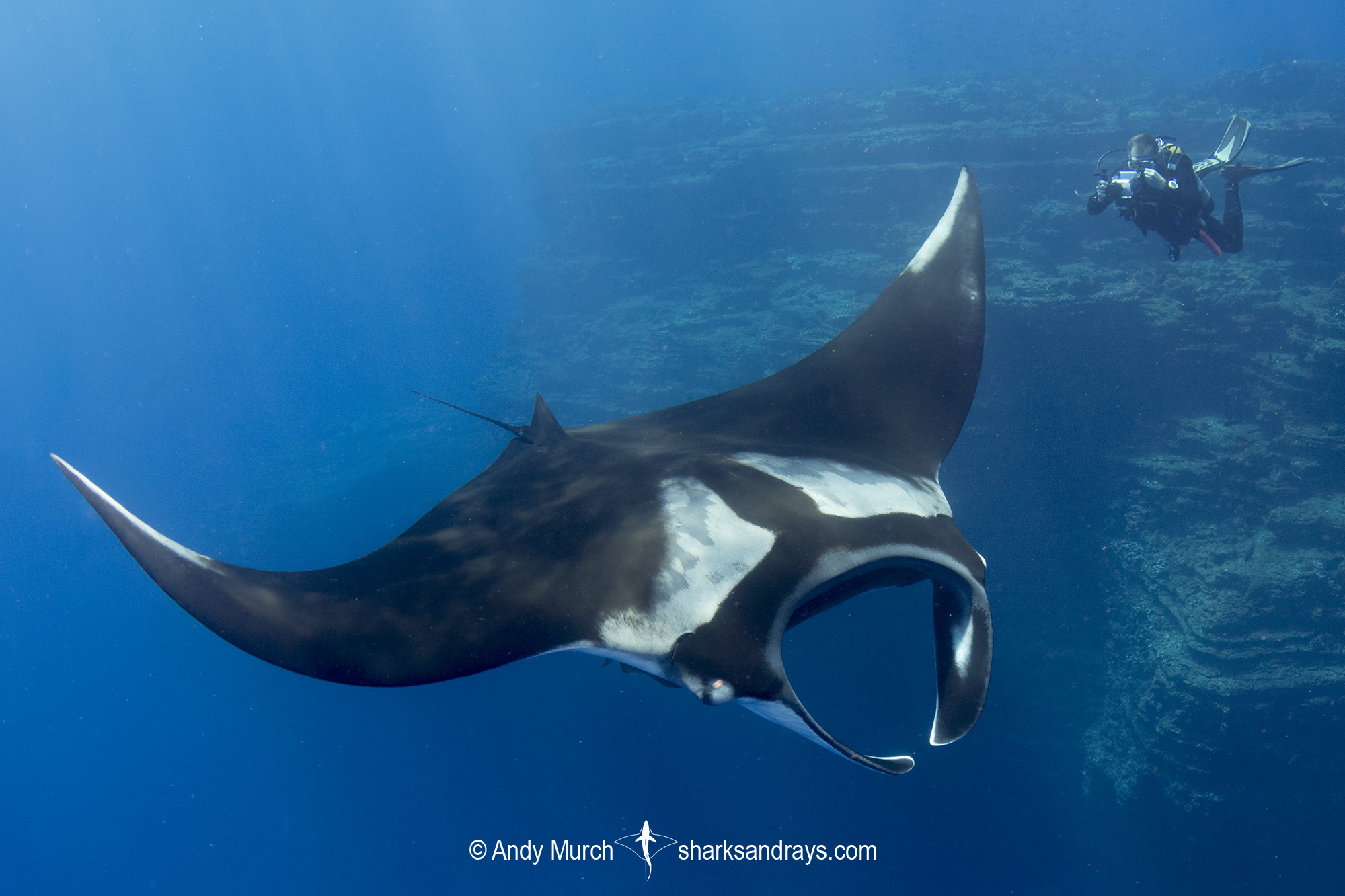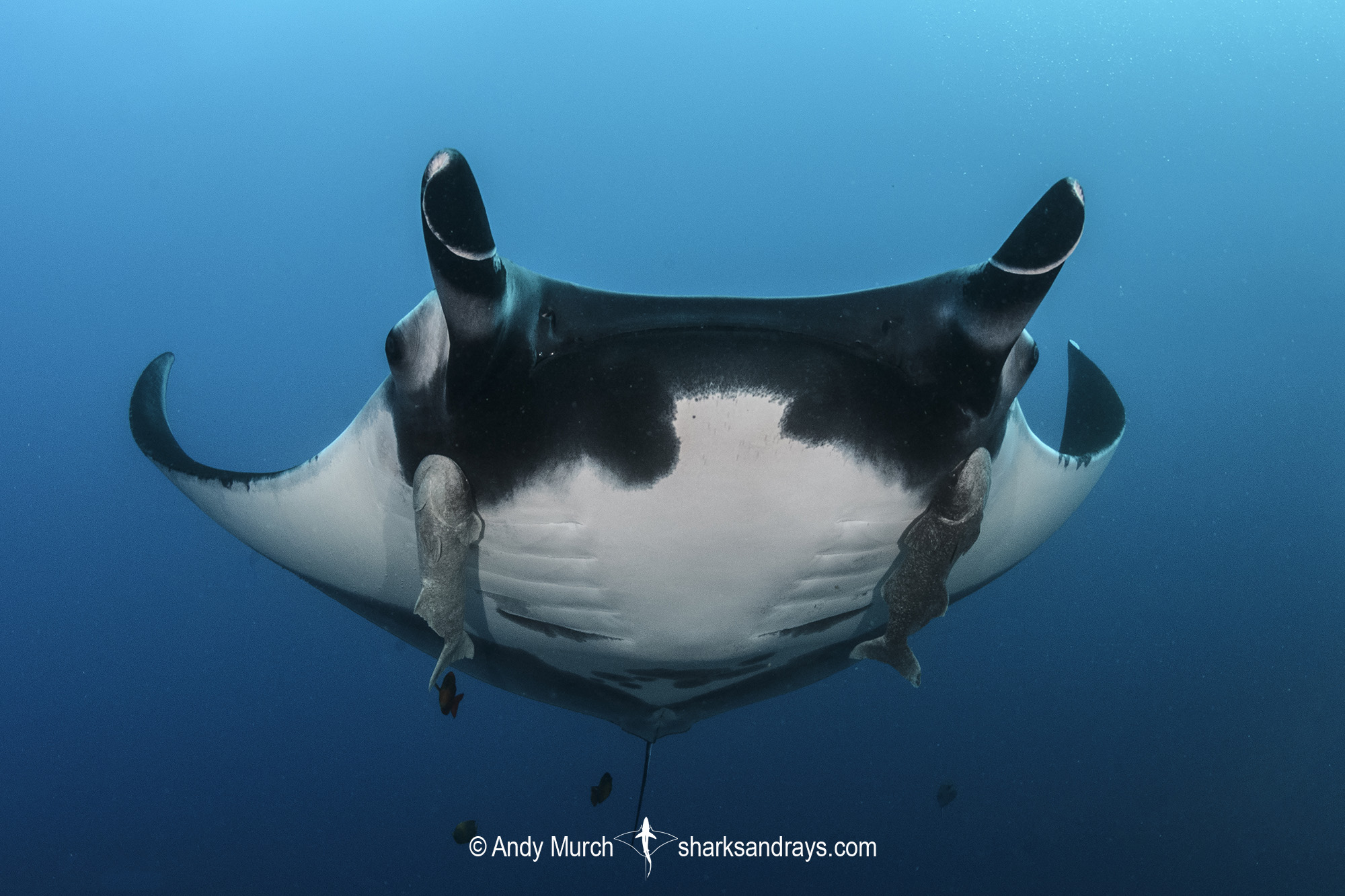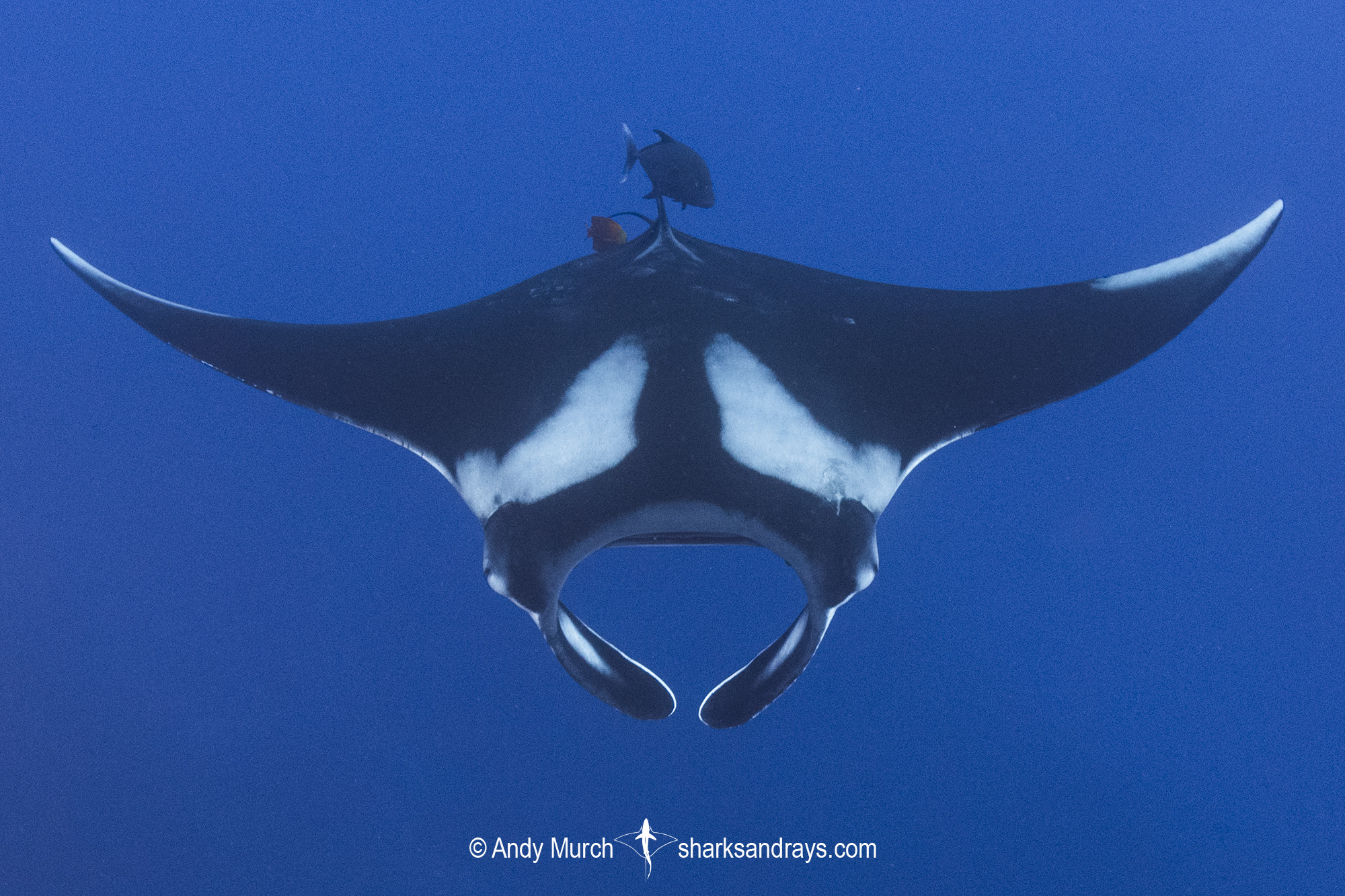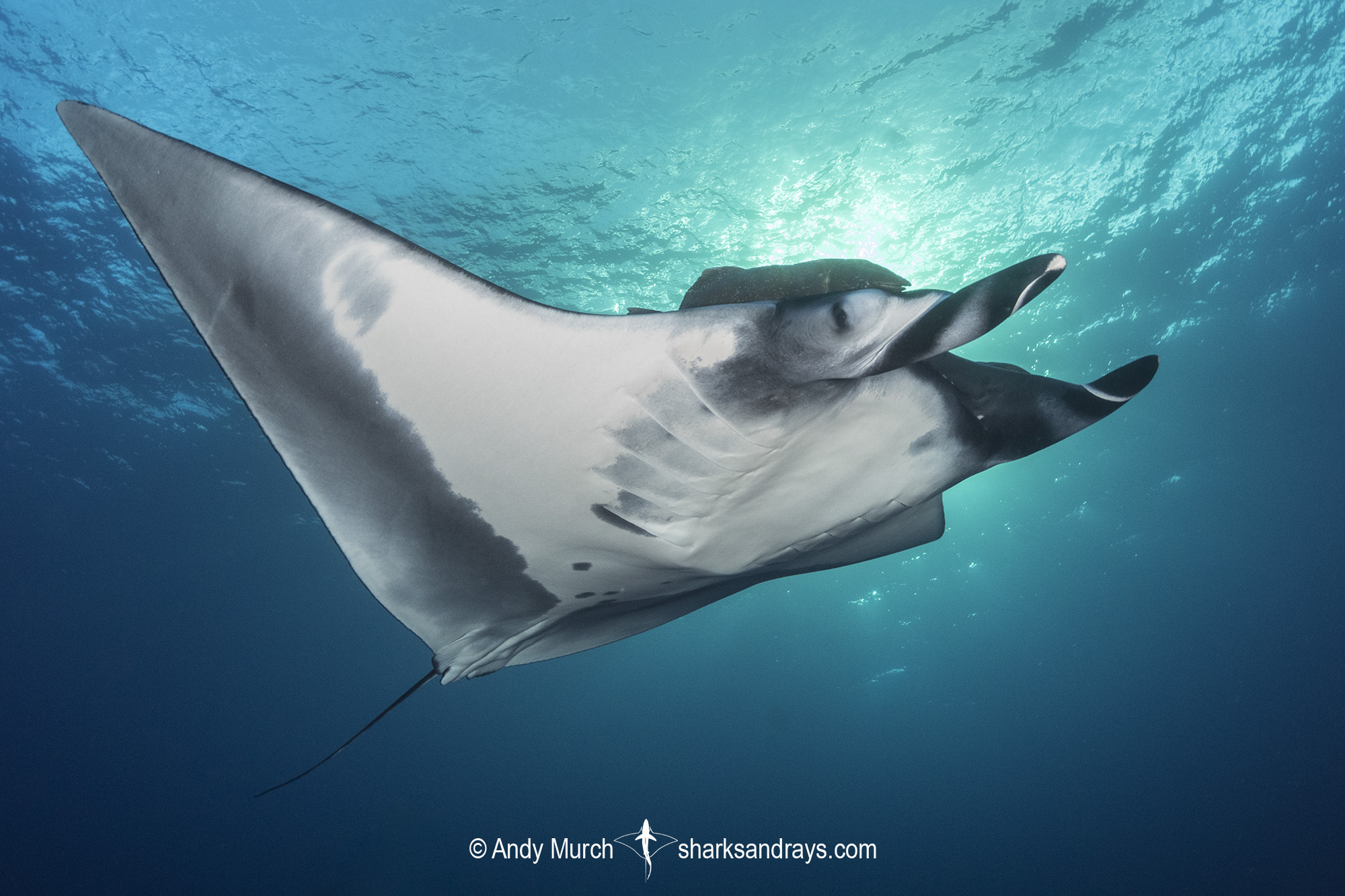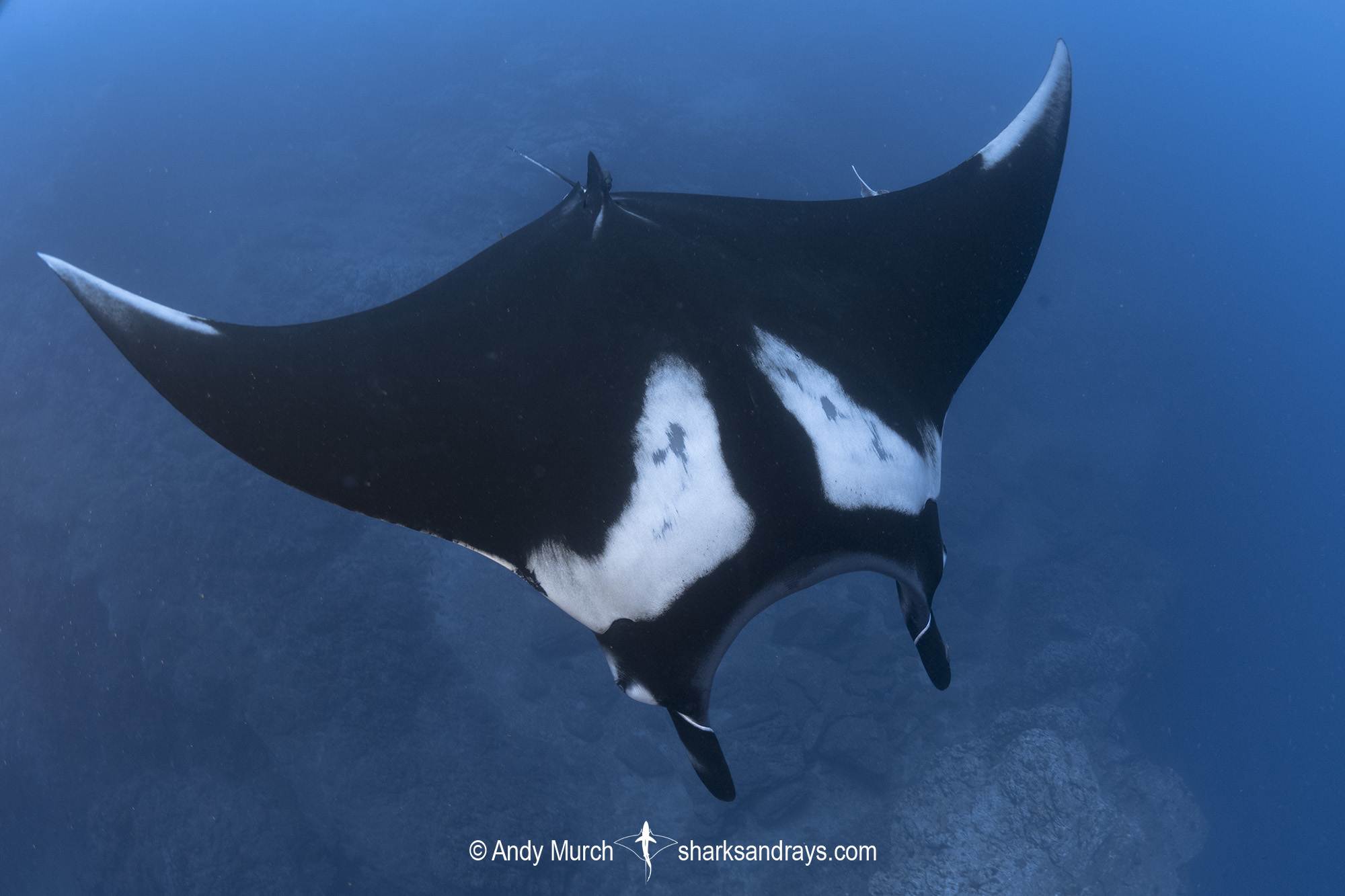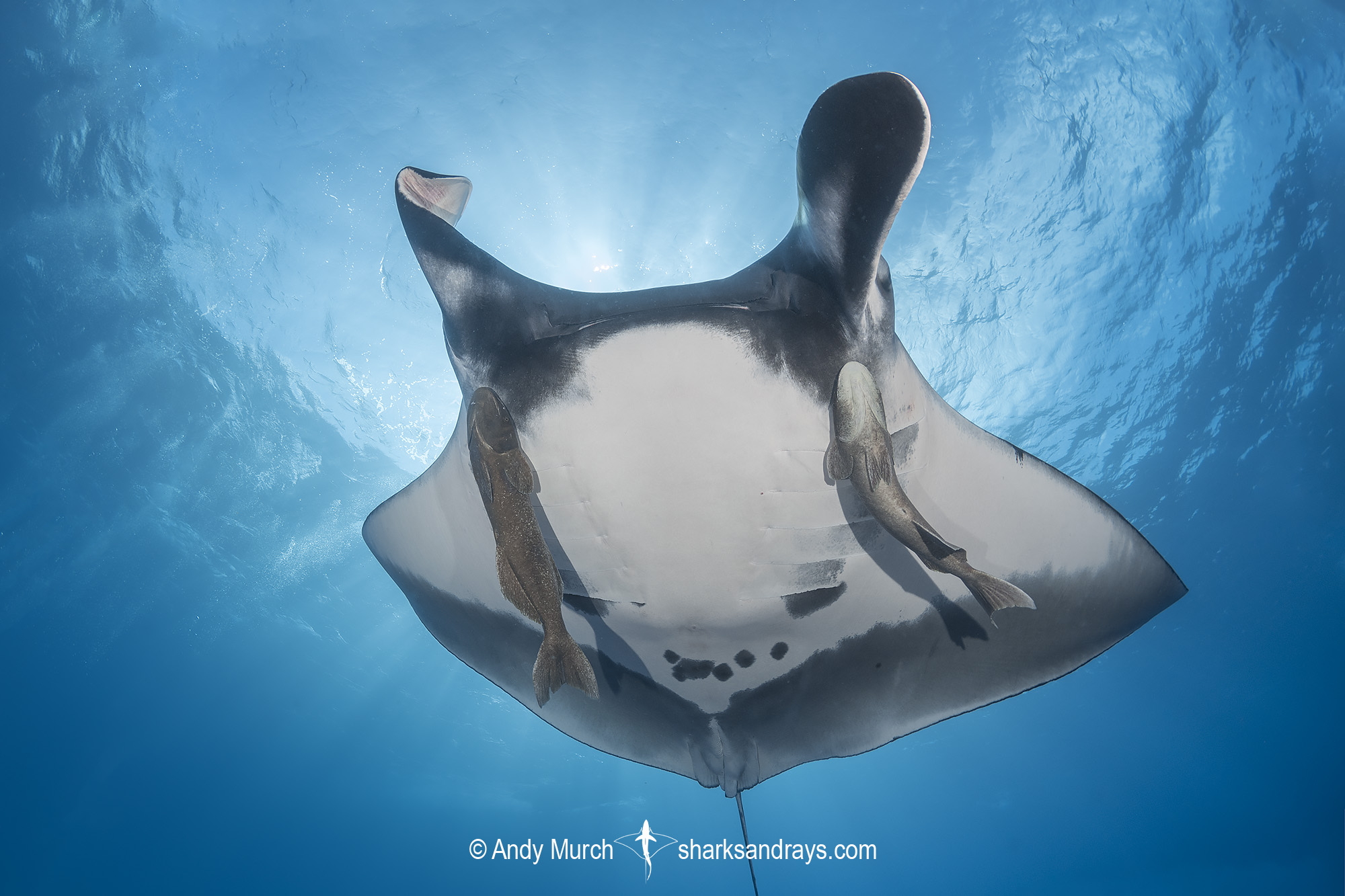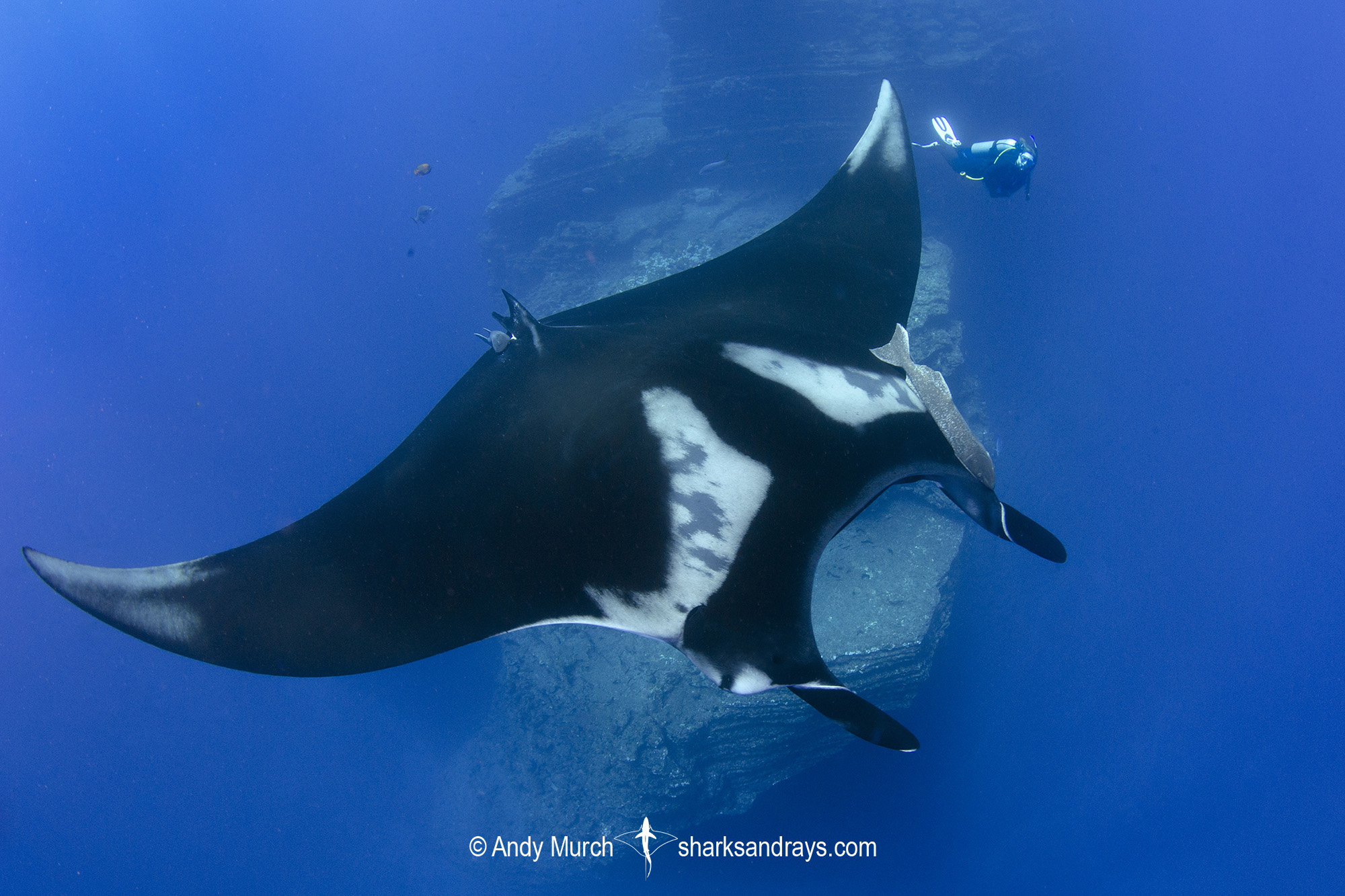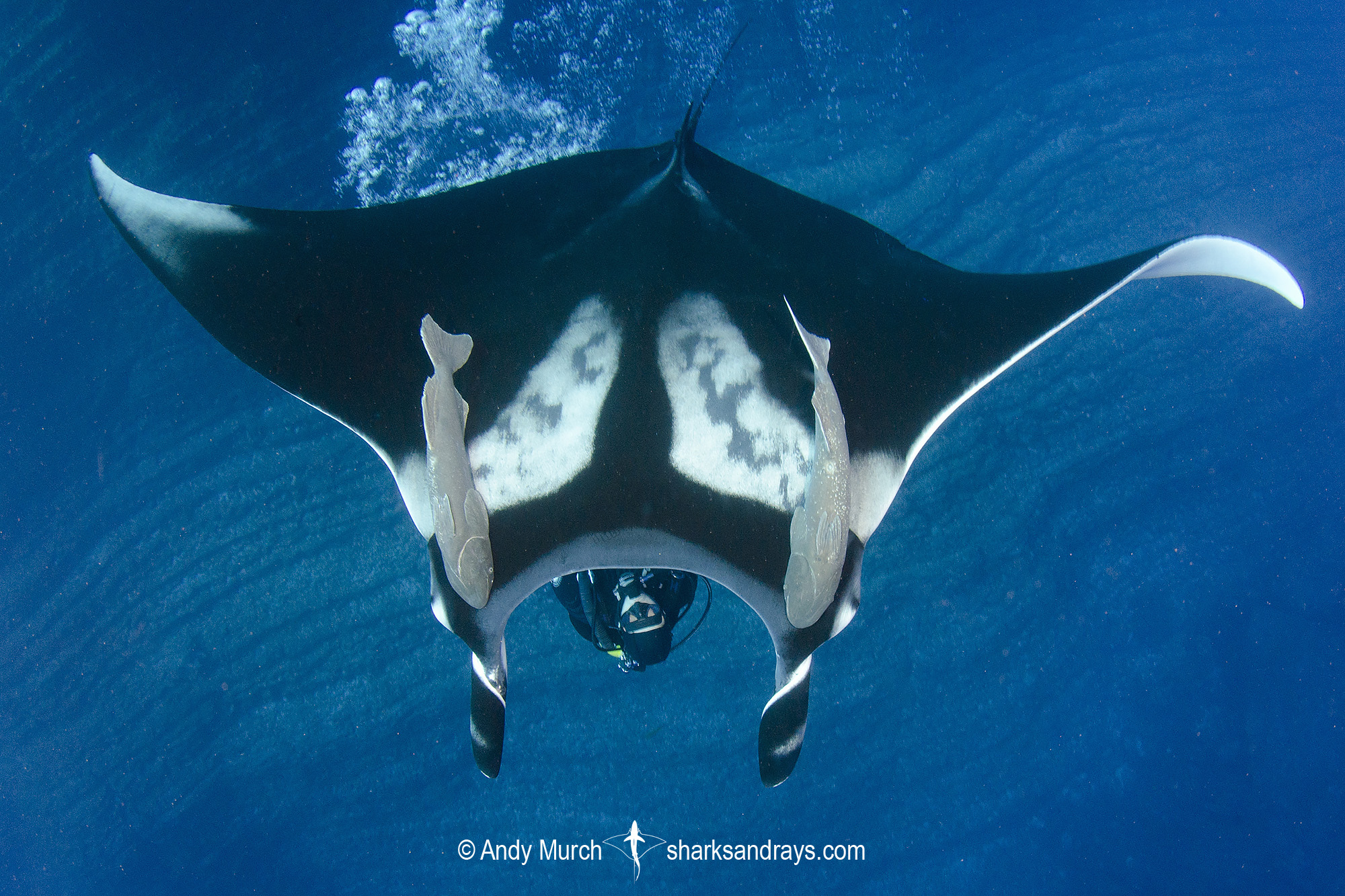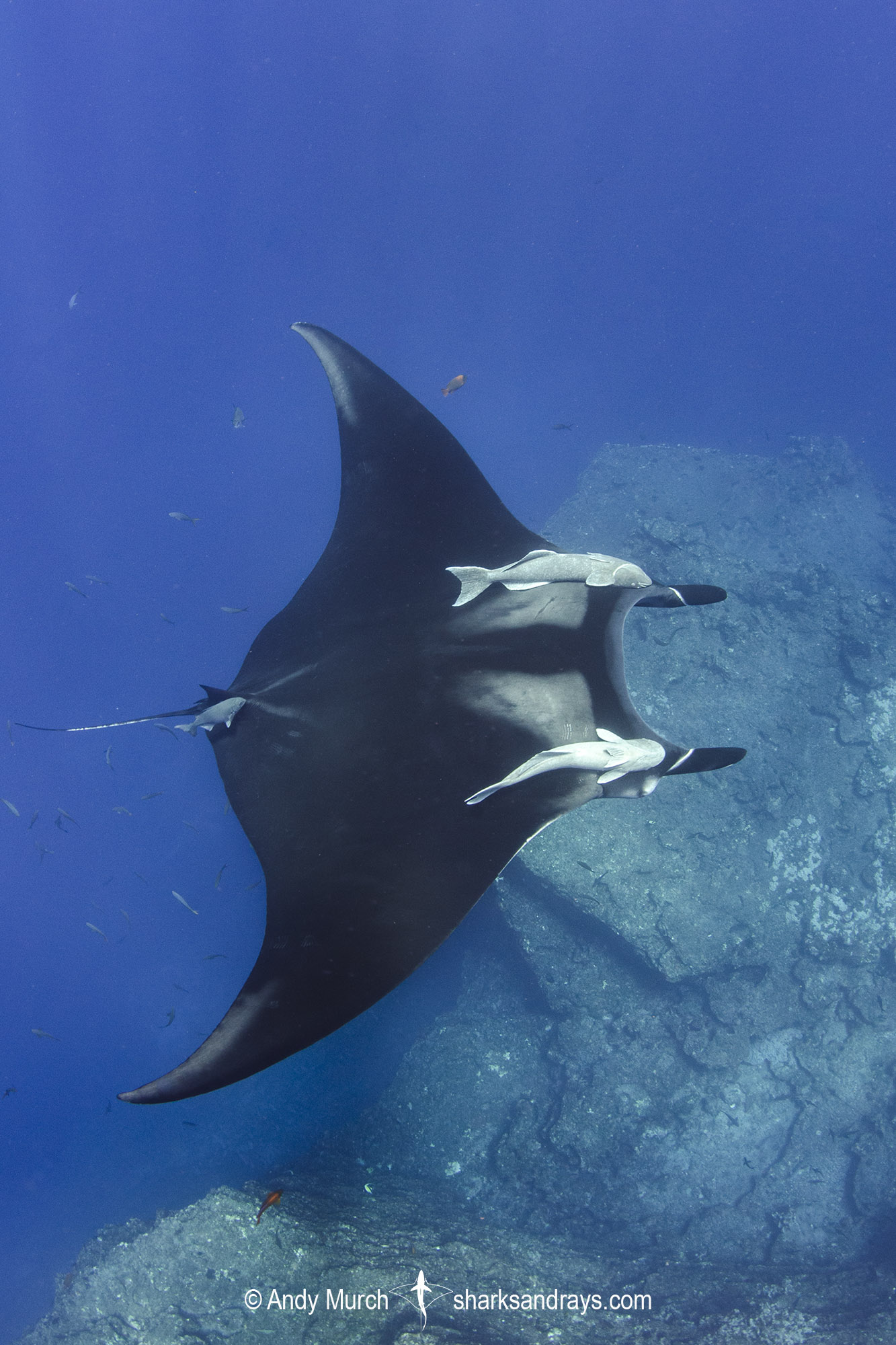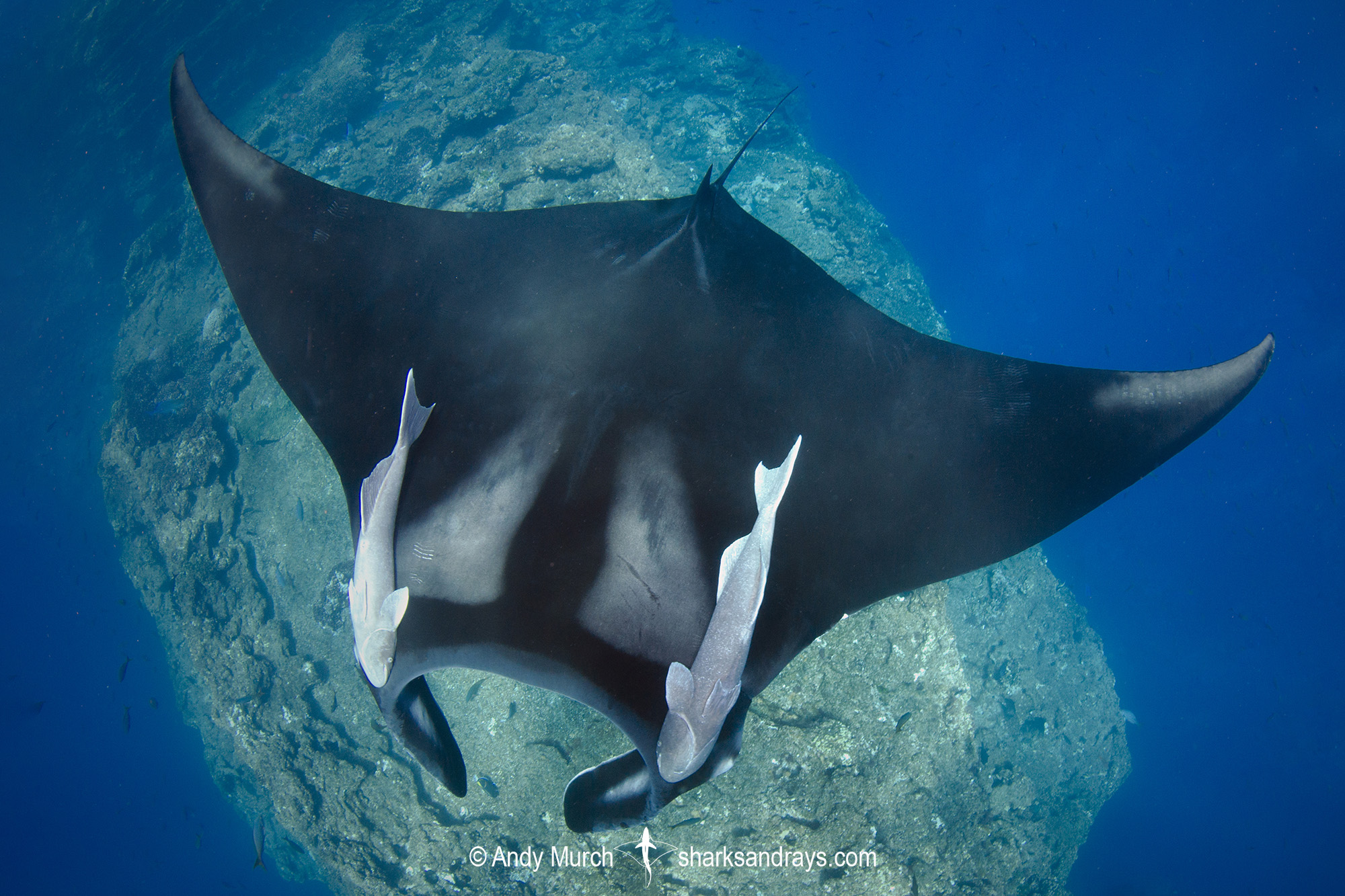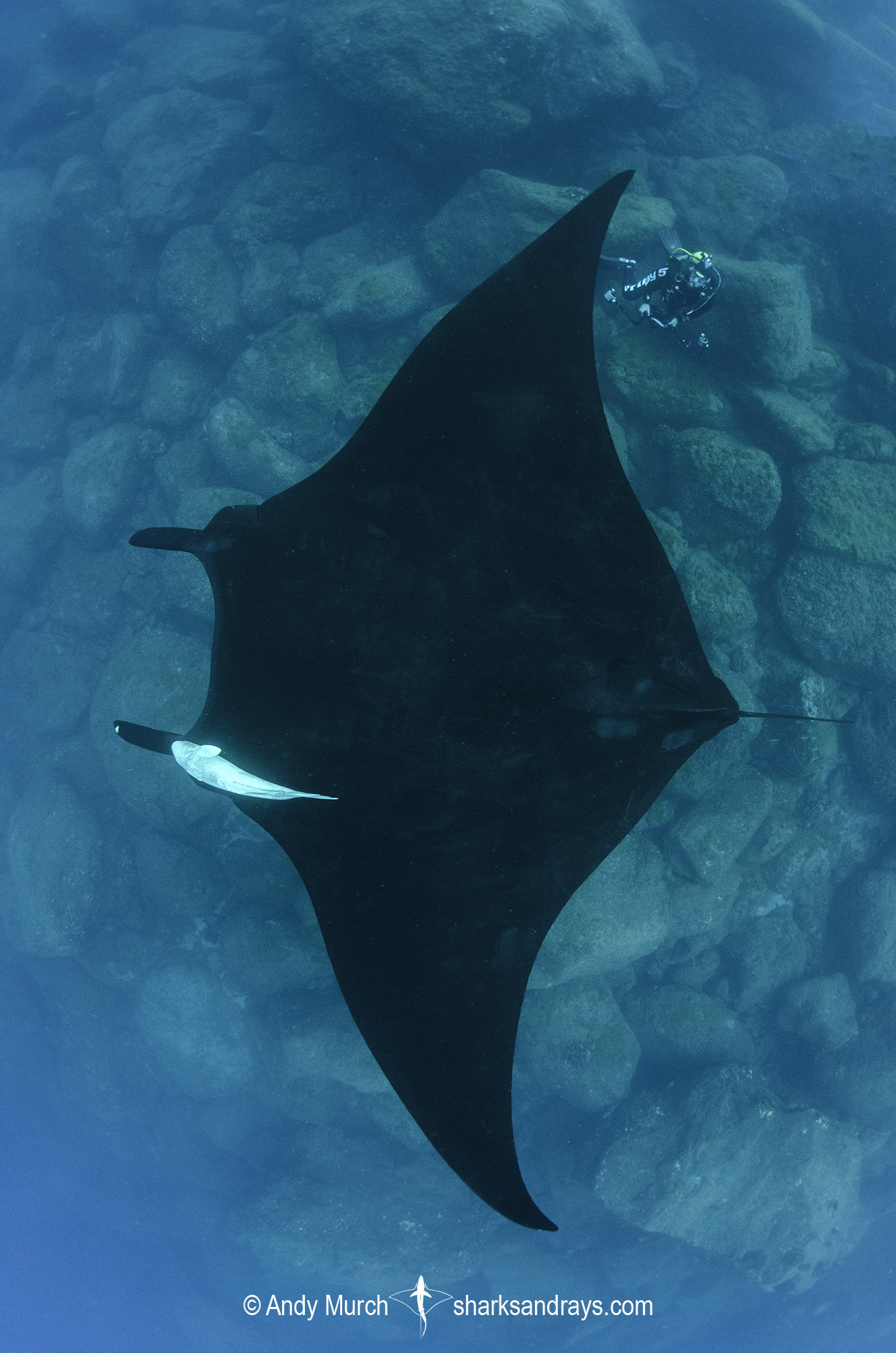Common name(s)
Oceanic Manta Ray, Giant Manta Ray, Manta Ray, Giant Devil Ray.
Identification
An extremely large ray with a vaguely kite-shaped disc and a large protruding head with a wide, terminal mouth. Disc width approximately 2.1-2.3 x length. Pectoral fins narrowly falcate, with convex anterior margins and concave posterior margins. Pectoral fin apices acutely pointed. Pelvic fins very small. One small dorsal fin present at base of tail; not falcate.
Head pronounced; extending well forward of pectoral fins. Slit-like spiracles posterior to eyes. Mouth very broad; 16-17% of disc width. Cephalic lobes long, broad, and highly flexible.
Denticle bands present on upper jaw. Band of vestigial teeth present on lower jaw.
Ridges of dermal denticles run lengthwise along upper and lower surfaces of disc. Tail whiplike. One small caudal sting encased in a noticeable calcified bulge near base of tail.
Colour
STANDARD: Dorsum predominantly black, usually with varying white or grey shoulder markings. Anterior margin of shoulder patterns level with spiracles, run parallel to curve of upper jaw. V-shaped marking anterior to tail extends forward to mid-back, occasionally curving outward to reach pectoral fin apices. Mouth and inner surface of cephalic lobes usually black or dusky; outer/ventral surface white.
Ventrum mostly white with distinct black spots on 5th gill slits and highly variable dusky or black markings elsewhere. Tail uniformly black.
BLACK VARIATION: Dorsum, mouth, and cephalic lobes uniformly black. Ventrum either completely black or with a highly variable central white flash.
WHITE VARIATION: Similar to the standard pattern but with white pectoral fin apices that often merge into shoulder markings and V on back. Tail white.
Size
Maximum disc width at least 700cm. Disc width at birth unknown.
Habitat
Pelagic in tropical/subtropical and warm temperate seas. Inhabits coastal areas with strong upwellings, oceanic islands and seamounts, and open ocean. Surface to at least 1000m.
Distribution
Circumtropical/subtropical.
Conservation Status
ENDANGERED
Oceanic manta ray aggregations are sparsely distributed and while individuals are capable of long-distance movements they do so infrequently and exhibit a degree of philopatry resulting in a high likelihood of local depletion. The global population size is not known, but local and regional abundance has been estimated and is mostly small, numbering less than 500 individuals, except for Ecuador where abundance is estimated at more than 2,000 individuals. The species has an extremely slow life history, producing only 1 pup on average every 4–5 years, and consequently is likely to have one of the lowest maximum rates of population increase (median 0.032 per year) of any elasmobranch. Giant Manta Rays are targeted or taken as bycatch in artisanal small-scale fisheries, as well as taken as bycatch in large-scale tuna fisheries. The meat is consumed locally, and the species is traded internationally due to the rapid rise of the valuable gill plate trade. Where Giant Manta Ray are protected (in over a dozen countries and territories), and hence where they are not being fished, the sighting trends appear stable. Elsewhere, however, very rapid declines have been noted in sightings records and landings where they are targeted or caught as bycatch; these range from 71 to 95% declines over 13- to 21-year periods (all less than one generation length of 29 years). It is suspected that the Giant Manta Ray has undergone a population reduction of 50–79% over the past three generation lengths (87 years), with further population reduction suspected over the next three generation lengths (2018–2105) due to current and ongoing levels of exploitation, and a reduction in area of occupancy due to suspected local and regional extinctions, and it is assessed as Endangered A2bcd+A3d.
Citation
Marshall, A., Barreto, R., Carlson, J., Fernando, D., Fordham, S., Francis, M.P., Derrick, D., Herman, K., Jabado, R.W., Liu, K.M., Rigby, C.L. & Romanov, E. 2020. Mobula birostris. The IUCN Red List of Threatened Species 2020: e.T198921A68632946. https://dx.doi.org/10.2305/IUCN.UK.2020-3.RLTS.T198921A68632946.en. Downloaded on 28 February 2021.
Reproduction
Aplacental viviparity. 1 pup per litter with a maximum 4–7 pups during its estimated lifespan.
Diet
Diet mainly planktonic organisms and some small bony fishes.
Behavior
An active swimmer that may be solitary or in small or large aggregations. Stays in shallow water during the day to rest, socialize and visit cleaning stations. Often moves into deeper water at night to feed in nutrient-rich ocean upwellings.
Considered extremely intelligent. Oceanic manta rays have a heat exchange mechanism that warms oxygen-rich blood as it moves from the gills to the brain. At cleaning stations in the Revillagigedo Islands, mantas visiting cleaning stations appear to actively seek out divers, seemingly enjoying the feel of diver’s exhaust bubbles trickling over their bellies. Anecdotal stories exist of hooked or entangled manta rays approaching divers for assistance but it is easy to misinterpret their intentions (if any).
Reaction to divers
Variously shy, tolerant, or curious depending on location.
Diving logistics
REVILLAGIGEDO ARCHIPELAGO, MEXICO.
Reliable spots to see oceanic manta rays exist throughout the tropics but the most rewarding encounters take place at the Revillagigedo Archipelago (a.k.a. Socorro) south of Baja off the Pacific coast of Mexico. There are numerous manta cleaning stations throughout the archipelago but the most famous spot for interactions is at a dive site called The Boiler; a rocky seamount on the northwest side of San Benedicto Island. At this location the mantas appear to ‘enjoy’ interacting with divers, returning time after time to feel their exhaust bubbles rolling over their bellies.
The archipelago is quite far from shore and can only be visited by multi-day liveaboard dive vessels that leave from the southern tip of Baja for the overnight journey to the islands.
ISLA MUJERES, MEXICO.
Scores of mantas often show up to join the huge aggregation of whale sharks that feasts on clouds of tuna eggs each summer off of the Yucatan Peninsula. Although these may be oceanic manta rays, there is work being done to describe this population as a separate species.
What’s new
View our full list of updates
Similar species
Reef Manta Ray Distinguished by less pronounced head, lack of bulge at base of tail, and differing shoulder and ventral markings.



